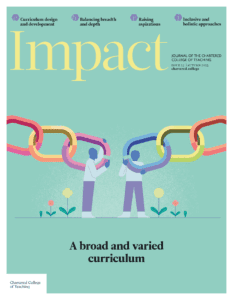Place and space in drama education
Written by: Carolyn Bradley

7 min read
CAROLYN BRADLEY, SCHOOL OF PERFORMANCE AND CULTURAL INDUSTRIES, UNIVERSITY OF LEEDS, UK
This paper defines the relationship between place, space and learning in drama, arguing that both schools and cultural venues can function as places of learning. Place and space discourses are complex in general, and difficult to fully address in the scope of this article; therefore, the focus here will be limited to concepts of place and space in relation to the drama curriculum. I will briefly discuss schools as places and spaces of learning, before examining place-based education theories and how we can turn to the place beyond the school building to fulfil the needs of a drama curriculum.
I define place to be a geographical location – a setting in which for action to happen, but something that can also be connected to belonging and identity, through our relationship to place (Agnew et al., 2003). Space is fluid, socially constructed and politicised (Massey, 2005). Smith (2020) contrasts
Join us or sign in now to view the rest of this page
You're viewing this site as a guest, which only allows you to view a limited amount of content.
To view this page and get access to all our resources, join the Chartered College of Teaching (it's free for trainee teachers and half price for ECTs) or log in if you're already a member.
- Agnew JA, Shelley FM and Pringle DG (2003) Agnew JA 1987: Place and politics: The geographical mediation of state and society. Progress in Human Geography 27(5): 605–614.
- Coleman C and Thomson A (2021) No drama: Making do and modern learning in the performing arts. In: Wright N and Koo E (eds) Pedagogy and Partnerships in Innovative Learning Environments: Case Studies from New Zealand Contexts. Singapore: Springer, pp. 97–119.
- Cultural Learning Alliance (2023) The current state of school buildings and art spaces in England. Available at: www.culturallearningalliance.org.uk/the-current-state-of-school-buildings-and-arts-spaces-in-england (accessed 27 March 2025).
- Department for Education (DfE) (2017) Drama: GCSE subject content. Available at: https://assets.publishing.service.gov.uk/media/5a7f5bc5e5274a2e87db55fc/Drama_GCSE_revised2017_FORMATTED__004_.pdf (accessed 18 July 2025).
- Department for Education (DfE) (2025) Curriculum and Assessment Review: Interim report. Available at: https://assets.publishing.service.gov.uk/media/6821d69eced319d02c9060e3/Curriculum_and_Assessment_Review_interim_report.pdf (accessed 18 July 2025).
- Greene JP, Erickson HH, Watson AR et al. (2018) The play’s the thing: Experimentally examining the social and cognitive effects of school field trips to live theater performances. Educational Researcher 47(4): 246–254.
- Holt-White E, O’Brien D, Brook O et al. (2024) A class act: Social mobility and the creative industries. The Sutton Trust. Available at: www.suttontrust.com/wp-content/uploads/2024/11/A-Class-Act-1.pdf (accessed 18 July 2025).
- Massey DB (2005) For Space. London: SAGE.
- Monahan T (2002) Flexible space & built pedagogy: Emerging IT embodiments. Inventio 4(1): 1–19.
- Morris TH (2020) Experiential learning – a systematic review and revision of Kolb’s model. Interactive Learning Environments 28(8): 1064–1077.
- National Audit Office (2023) Report: Condition of school buildings. Available at: www.nao.org.uk/wp-content/uploads/2023/06/condition-of-school-buildings.pdf (accessed 25 March 2025).
- Neelands J (2004) Miracles are happening: Beyond the rhetoric of transformation in the Western traditions of drama education. Research in Drama Education 9(1): 47–56.
- Nind M, Köpfer A and Lemmer K (2022) Children’s spaces of belonging in schools: Bringing theories and stakeholder perspectives into dialogue. International Journal of Inclusive Education 29(2): 210–222.
- Smith N (2020) Uneven Development: Nature, Capital, and the Production of Space. London: Verso.
- Sobel D (2004) Place-Based Education: Connecting Classrooms and Community. Massachusetts: Orion.
- Thomson P, Hall C and Maloy L (2025) The RAPS Report: Researching the Arts in Primary Schools. University of Nottingham and Freelands Foundation. Available at: https://artsprimary.com/wp-content/uploads/2025/02/raps-final-feb-2025--4.pdf (accessed 18 July 2025).
- University of Nottingham, Royal Shakespeare Company (RSC) and Tate (2019) Time to Listen: Evidence from the Tracking Arts Learning And Engagement (TALE) project. Available at: https://researchtale.net/wp-content/uploads/2019/07/time-to-listen-tale-project-final-report.pdf (accessed 20 March 2025).
- Yemini M, Engel L and Ben Simon A (2023) Place-based education – a systematic review of literature. Educational Review 77(2): 640–660.
0
0
votes
Please Rate this content
Please login to comment
0 Comments
Oldest
Newest
Most Voted
Inline Feedbacks
View all comments










